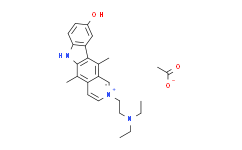| Cas No.: | 105118-14-7 |
| Chemical Name: | 6H-Pyrido[4,3-b]carbazolium,2-[2-(diethylamino)ethyl]-9-hydroxy-5,11-dimethyl-, chloride (1:1) |
| Synonyms: | 6H-Pyrido[4,3-b]carbazolium,2-[2-(diethylamino)ethyl]-9-hydroxy-5,11-dimethyl-, chloride (1:1);2-[2-(diethylamino)ethyl]-5,11-dimethyl-6H-pyrido[4,3-b]carbazol-2-ium-9-ol,chloride;Datelliptium;Datelliptium chloride;2-(2-(Diethylamino)ethyl)-9-hydroxy-5,11-dimethyl-6H-pyrido(4,3-b)carbazolium chloride;2-[2-(diethylamino)ethyl]-9-hydroxy-5,11-dimethyl-6H-pyrido[4,;Chlorure de datelliptium;Chlorure de datelliptium [French];Cloruro de dateliptio;Cloruro de dateliptio [Spanish];Datelliptii chloridum;Datelliptii chloridum [Latin];Datelliptium chloride [INN];N-2-(Diethylaminoethyl)-9-hydroxyellipticinum chloride;UNII-L374Y6WE0D;UNII-V5QKF7Q20O |
| SMILES: | CC1=C2C(NC3=C2C=C(O)C=C3)=C(C)C4=CC=[N+](CCN(CC)CC)C=C41.[Cl-] |
| Formula: | C23H28N3O+.C2H3O2- |
| M.Wt: | 421.53194 |
| Purity: | >98% |
| Sotrage: | 2 years -20°C Powder, 2 weeks 4°C in DMSO, 6 months -80°C in DMSO |
| Description: | Datelliptium chloride is a DNA-intercalating agent derived from ellipticine, with anti-tumor activities. |
| In Vivo: | Upon intravenous administration, datelliptium acetate shows potent inhibitory activities in vivo against a variety of murine solid tumors. Datelliptium acetate is highly active against early-stage colon #38 with highest non-toxic dose (HNTD) of 170 mg/kg TD, and weight loss of 10%, T/C of 0%[2]. |
| In Vitro: | Datelliptium (100 μM) shows significantly cytotoxic effects after 2 hr of treatment in suspension and primary cultures of rat hepatocytes. Datelliptium mobilizes glycogen in both rat systems in vitro concentration dependently. The half-maximal effect is 14.3 μM in isolated hepatocytes, whereas in cultured rat hepatocytes it is 5.9 μM. Datelliptium also leads to a concentration-dependent decrease in gluconeogenesis from lactate in cells[1]. Datelliptium acetate is selectively cytotoxic for solid tumors over leukemia L1210. Human tumors H-125 and HCT-116 demonstrates less sensitivity to datelliptium acetate[2]. |
| Cell Assay: | Cytotoxicity is estimated after short-term exposure (2 hr) to datelliptium using suspended and cultured rat hepatocytes. When cytotoxicity is evaluated after longer-term exposure, using human and rat monolayers and hepatoma cell lines, the compound is added 1 hr after cell plating and incubated for 23 hr. The loss of intracellular LDH and the MTT test are the endpoints evaluated in cultured cells. The intracellular LDH is measured in the microwell culture plates by a colorimetric method. The MTT test, reduction of the tetrazolium salt MTT to formazan by mitochondrial succinate dehydrogenase, is performed as described. Cytotoxicity in the hepatocyte suspension is evaluated by LDH leakage to the medium after a 2-hr treatment with the drug. |
| References: | [1]. Donato MT, et al. Toxicity of the antitumoral drug datelliptium in hepatic cells: Use of models in vitro for the prediction of toxicity in vivo. Toxicol In Vitro. 1992 Jul;6(4):295-302. [2]. Mucci-LoRusso P, et al. Activity of datelliptium acetate (NSC 311152; SR 95156A) against solid tumors of mice. Invest New Drugs. 1990 Aug;8(3):253-61. |

 DC Chemicals' products qualify for U.S. tariff exemptions. We guarantee no price increases due to customs duties and maintain stable supply, continuing to deliver reliable research solutions to our American clients.
DC Chemicals' products qualify for U.S. tariff exemptions. We guarantee no price increases due to customs duties and maintain stable supply, continuing to deliver reliable research solutions to our American clients.





















